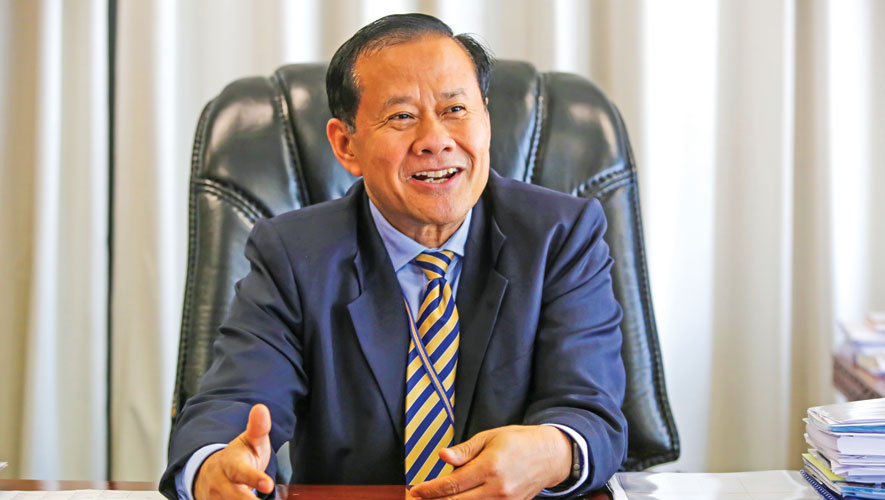With loans and deposits remaining high, financial advocacy and consumer protection are considered by experts to be essential to push the sector to maintain healthy growth and support financial inclusion.
For the latest Cambodian Business news, visit Khmer Times Business
Financial literacy is an often-used term which is rarely understood by the masses.
It means the convergence of financial, credit and debt management and the knowledge that is necessary to make financially responsible decisions – decisions that are integral to our everyday lives and futures.
Speaking at the National Financial Literacy Day in April this year, National Bank of Cambodia (NBC) Deputy Governor Neav Chanthana said improving financial literacy in the country can boost national economic growth, aid the development of the financial sector and increase people’s incomes.
“Our goal is to improve financial literacy. To do this, we need the participation and support of the government, the private sector and our development partners,” she said.
Neav requested the cooperation of all financial institutions in the country to achieve this objective.
“Banks and microfinance institutes should allocate money to train their staff on matters of financial literacy so that they can spread this information to the public,” she said.
Financial literacy affects the daily issues an average family faces when trying to balance a budget, buy a home, fund children’s education and ensure a retirement income.

Chairman, Association of Banks, Cambodia
Quagmire of burden
In many countries, Cambodia included, financial literacy is a key factor in sustainable financial development to contribute national, social, economic development. Without it, the masses will be trapped in a quagmire of burden from which even the state may not be able to rescue them.
At presents, a lot of banks and microfinance institutions are putting the public’s financial literacy at the top of their agendas. It is to align with the central bank’s agenda and remain competitive with the rise of competition in the country’s fiscal sector.
“We are big advocates of financial literacy because we believe it is actually leading to financial inclusion, so that more people can benefit from financial services and products so that they can improve their lifestyles,” says Shin Chang Moo, president of PPCBank.
He says that the bank is trying to make all the bank’s procedures and processes easier because many ordinary customers in Cambodia feel that banking is very difficult because there are so many documents to be filled in.
He says the bank is working very closely with NBC because its big agenda is financial literacy and financial inclusion. “So we are the biggest supporter of the NBC. At the same time, we have own our financial education programme,” he says.
The financial education programme is important in the financial sector, says Chief Executive Officer of microfinancier LOLC (Cambodia) Sok Voeun.
“We want the financial operators and consumers to be aware of financial literacy it will make operations work well in terms of equity and transparency,” he says.
Educational programme
Sok says that when the customers want to receive services from LOLC, our staff always sit with them and explain the terms of the loan and the repayments. In addition to that, LOLC is also offering an educational programme to its customers and non-customers in the community about financial literacy.
“We explain to them about saving, cash-flow management, over-indebtedness, micro-business management, or we talk about the products which are suitable for farmers and micro-businesses and how they should manage their life skills to adapt to our loan system and to improve their business and manage cash-flow well to improve their family’s lives,” he adds.
“Regarding consumer protection, we have done a lot. LOLC has client protection principles and what we have done is to ensure that our products and services are suitable for the real needs of customers at an affordable price, suitable for their business and they can get results and profit so we grow together,” he adds.
“We will not allow them to borrow too much, but we allow them to borrow according to their ability – and we protect them. Even though customers may be in a critical position regarding payments, we sit with them and resolve matters peacefully to make it a win-win strategy,” Sok points out.
Access to finance in Cambodia ranked in third place in the world, according to a World Bank report. This means awareness of the customers about financial literacy in Cambodia is high at present, says In Channy, chairman of the Association of Banks in Cambodia.
“If they do not understand, they will not use the banking services and finance. And if the agent of the banks do not have knowledge, they cannot promote it. Thus, our people are more aware of it now,” In adds.

In stresses that capacity building is very important to allow the bank’s human resources to teach customers. Now, teaching customers is very important. He says that how to calculate interest rates must be taught in high school.
“They should know about interest rates so they can calculate them by themselves. And all agents should continue teaching them – and this knowledge should be embedded in primary schools, so we want it widely available,” he adds.
Financial literacy forms the backbone of the financial sector development strategy 2016-2025 which mandated relevant governmental institutions to organise programmes to promote it in order to enhance financial knowledge among the public, especially for the preparation of the national general academic programme, according to the NBC.
The NBC’s report in the first half of 2019 shows that outstanding deposits in the banking and finance sectors increased to 6.8 million accounts, while 3 million people had outstanding loans in them during the same period. On top of that, customers using the payment services numbered 4 million people.
Loans increasing in H1
In the first half of the year, 2019, loans in the banking and microfinance sectors rose by about 22.4 percent in, growing by $27.7 billion. The value of all outstanding loans has now reached $21.5 billion in the banking sector and $6.2 billion in the microfinance industry.
The NBC will continue its effort to strengthen financial literacy and encourage sound practice pertaining to individual borrowing. It says that a buildup of individual borrowings is partly a consequence of greater financial access, which could help foster economic growth and improve standards of living.
“The NBC would aim to strike a sustainable balance between financial inclusion and financial stability and, in doing so, deem financial literacy of the general public a crucial ingredient,” according to Neav.
Careful consideration
“Individuals are encouraged to carefully consider the terms and conditions of their borrowings and select the lenders from the NBC’s registered list to avoid unfair practices,” she adds.
Hong Cheap, head of Commercial Banking at CIMB Bank, said: “For CIMB, we are not focusing on giving them [consumers] a loan, but the bank’s staff will explain to customers the importance of the usage of the loan and its risk. He adds that the bank also studies the customer’s income to see whether he or she can pay back the loan they borrow or not.
“We are afraid that after they borrow our loan they may encounter a problem and the bank may confiscate their property, so it is not in our interests, especially at CIMB. We try to explain to them the circumstances around any loan they take out.”
Hong says the bank also has documents and other materials that help potential borrowers to understand more about the products and services. The documents will explain the benefits they may be receiving. The bank will also study their needs and try provide them with the necessary documents to study, he adds.
“What we are proud of is the fact CIMB’s non-performance loans (NPL) are very low, almost nonexistent. Thus, it reflects that what we have worked out with customers is good. However, when acustomers borrows a loan from the bank and encounters a problem, it will cause the customer trouble and the bank will also have an issue on loan defaults,” says Hong.
According to Hong, “in general we cannot say how much financial education could help reduce risk, but what we can see is that they are aware and understand more so that they can select a loan or make a decision which loan is high risk or low risk for them, or whether they can repay it when they request a lot of money, so it is education that helps them to set their financial planning”.
Minister of Education Hang Choun Naron says the education ministry is in a collaboration with the NBC to embed financial literacy in the national curriculum from primary school to high school, starting from early next year.

A life skill
“We will strengthen mathematics in schools and we also include financial literacy. We will provide the knowledge to the young people and youth to know how to save money and how to spend money,” he adds.
“Financial literacy courses are just a life skill subject offering to students. It is a the requirement for the school to implement, but we reserve two hours per week for each school to allow teachers to choose the life skill subject to teach students,” he adds. Those include financial literacy, agriculture, entrepreneurship among others,” he adds.
“At present, the ministry has prepared the programme on financial literacy with the NBC, but it has yet to be included in the curriculum for the educational programme, but we encourage the school to add more about financial literacy in the curriculum because we cannot include all the subjects in the general education programme,” Hang says.
“We start with the primary school, to educate the students to know how to calculate numbers and understand how to spend and save money on daily living. At high school, financial literacy is taught at a higher level, including statistics. Teachers can choose it as a life skill to teach,” he adds.




